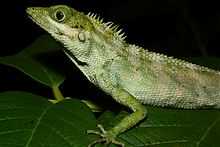Pseudocalotes andamanensis
| Andaman canopy agama | |
|---|---|
 | |
| Male, Andaman canopy agama, Pseudocalotes andamanensis | |
| Scientific classification | |
| Kingdom: | Animalia |
| Phylum: | Chordata |
| Class: | Reptilia |
| Order: | Squamata |
| Suborder: | Lacertilia |
| Family: | Agamidae |
| Subfamily: | Agaminae |
| Genus: | Pseudocalotes |
| Species: | P. andamanensis |
| Binomial name | |
| Pseudocalotes andamanensis (Boulenger), 1891[1] | |
The Andaman Canopy Agama (Pseudocalotes andamanensis)[2] is an agamid lizard endemic to the Andaman Islands.[3] It is also known as the Andaman Green Calotes.[4] This species is an almost exclusive canopy dweller, and is rarely seen.
The holotype of the Andaman Canopy Agama is an adult male from Andaman Islands, India; collected by Frederick Adolph de Roepstorff (1842-1896) on 7 January 1882.[5] It was recently rediscovered from the Andaman Islands.[6]
Description
The Andaman canopy agama has been noted as having enlarged keeled scales on caudal surface of thigh, obtusely keeled scales over head, smooth dorsal body scales (uppers six rows directed posterodorsally, remainder posteroventrally). It lacks body crest, antehumeral pit present. The Andaman canopy agama has 67 scales around its midbody. Its third toe is shorter than its fourth toe. This species is distinguished from Calotes aurantolabium, a southern Indian species with which it was confused for over a decade[7][8][9] in having relatively long head (HW:HL = 0.59); 56-67 longitudinal scale rows around midbody; dorsals and laterals smooth, sometimes weakly keeled near the sacral region; ventrals strongly keeled; dorsals of 4-7 paravertebral longitudinal rows larger than laterals, of irregular shape, pointing posterodorsally; laterals pointing posteroventrally; laterals and ventrals of similar size; ventrals slightly irregular; a row of enlarged scales between supralabials and orbit, bordered by one or two smaller scale rows; gular scales smaller than ventrals, weakly keeled; gular pouch present in males; antehumeral fold/pit weakly developed; nuchal crest composed of 11-15 lanceolate spines; dorsal crest a denticulate ridge; enlarged conical lamellae under the leading edge of third toe; 27- 30 lamellae under fourth toe; hind limb length 70-75 % of SVL; tail length 238-265 % of SVL, slightly compressed at the base. dorsal head scales obtusely keeled; parietal ridge raised; enlarged scale between nuchal crest and tympanum; antehumeral pit present; toe-IV longer than III; stretched hindlimb reaches eye. From P. tympanistriga, P. andamanensis differs in having a wider head (HW/HL = 0.59 in P. andamanensis, 0.52 in P. tympanistriga), longer hind limbs (70-75 % of SVL in P. andamanensis, 68% in P. tympanistriga), 9-10 supralabials and 9-12 infralabials (10-13 supralabials and 9-11 infralabials in P. tympanistriga). In having enlarged triangular lamellae on the leading edge of the third toe, this species is similar to the Indo-Chinese species group of Pseudocalotes. Distinguished from Calotes versicolor and Calotes liocephalus groups and C. rouxi and C. ellioti in presence of enlarged keeled scales on caudal surface of thigh. Distinguished from Calotes versicolor group lizards in scale orientation – distinguished from Calotes versicolor in having an antehumeral pit; distinguished from C. nemoricola and C. grandisquamis in having equal size dorsal and ventral scales, toe-IV longer than III, scales around midbody 67 (36-43 and 27-35 respectively); distinguished from C. calotes in lacking flattened spines above tympanum. Distinguished from C. ellioti and C. rouxi in having an antehumeral pit and in lacking spines. It is distinguished from the species Calotes liocephalus and similar lizards (C. ceylonensis, C. desilvai, C. liolepis, C. nigrilabris) in lacking spines on the head. It is distinguished from C. liocephalus by midbody scale count and body crest.[10]
For a period of time, this taxon included the species now reclassified as Calotes aurantolabium [11] The description given here is from the most recent publication, rather than the one of by Ishwar and Das (1998).
References
- ↑ http://reptile-database.reptarium.cz/species.php?genus=Calotes&species=andamanensis downloaded February 15, 2010.
- ↑ Harikrishnan, S.& Vasudevan, K. (2013) - Rediscovery of Calotes andamanensis Boulenger, 1891, and assessment of its generic allocation Herpetozoa, 26(1/2): 3 -13
- ↑ http://www.reefandrainforest.co.uk/wildlife-news.php Viewed February 17, 2010.
- ↑ http://www.reefandrainforest.co.uk/wildlife-news.php
- ↑ ( Zoological Museum collection, Københavns Universitet, Copenhagen, Denmark (ZMUC) 36944)
- ↑ Harikrishnan, S.& Vasudevan, K. (2013) - Rediscovery of Calotes andamanensis Boulenger, 1891, and assessment of its generic allocation Herpetozoa, 26(1/2): 3 -13
- ↑ Ishwar,N.M. & Das,I. 1998 Rediscovery of Calotes andamanensis Boulenger 1891, and a reassessment of the type locality. J. Bombay Nat. Hist. Soc. 95: 513-514
- ↑ Krishnan, S. 2008. New Species of Calotes (Reptilia: Squamata: Agamidae) from the Southern Western Ghats, India. Journal of Herpetology. 42:3 530-535.
- ↑ Harikrishnan, S.& Vasudevan, K. (2013) - Rediscovery of Calotes andamanensis Boulenger, 1891, and assessment of its generic allocation Herpetozoa, 26(1/2): 3 -13
- ↑ http://reptile-database.reptarium.cz/species.php?genus=Calotes&species=andamanensis downloaded February 15, 2010.
- ↑ Krishnan,. S http://www.bioone.org/doi/abs/10.1670/06-198.1?journalCode=hpet.
- Boulenger,G.A. 1891 On new or little known Indian and Malayan reptiles and batrachians. Ann. Mag. nat. Hist. (6) 8: 288-292
- Ishwar,N.M. & Das,I. 1998 Rediscovery of Calotes andamanensis Boulenger 1891, and a reassessment of the type locality. J. Bombay Nat. Hist. Soc. 95: 513-514
- Ishwar, N. M. 2001. Reptilian Species Distribution in Response to Habitat Fragmentation and Microhabitats in the Rainforests of Southern Western Ghats, India. Unpubl. Ph.D. diss.,. Forest Research Institute (Deemed University). Uttaranchal, India.
- Krishnan, S. 2008. New Species of Calotes (Reptilia: Squamata: Agamidae) from the Southern Western Ghats, India. Journal of Herpetology. 42:3 530-535.